
12 minute read
eatre Born in Con ict Zones 11’ A Girl’s Struggle Re ect Our Current World — e Dramatic Reading of Liberian Girl / Hamada Motoko

Advertisement
Liberian Girl (from the left) Kane Suzuki, Kawabe Kunihiro, Nagatomi Chiaki, Isoda Mie, Okuda Ippei, Yoshino Yoshiko
Special Feature
‘Theatre Born in Conflict Zones’ A Girl’s Struggle Reflect Our Current World —The Dramatic Reading of Liberian Girl
Hamada Motoko
During wartime and conflicts, it is not just the soldiers fighting on battlefields who become victims. Needless to say, wars and conflicts should never happen but once they start, civilians also become victims. Sexual violence toward women is a serious problem not only during times of peace but also in times of war. It is said that sexual assaults on women first drew attention during the war in former Yugoslavia in the 1990s.
In 2018, the Nobel Peace Prize was awarded to a doctor from the Democratic Republic of Congo, who had fought against sexual violence in conflict, and also to a human-rights activist, who came back alive after being sexually abused by the soldiers of the Islamic
State (IS). They were chosen for their efforts to end the use of sexual violence against women as a weapon of war and armed conflict, which showed the strong resolution of the international society.
Adding fiction, the horrifying realities of violence and injustice that go unchecked and punished in conflicted countries are depicted in Diana Nneka Atuona’s immersive play Liberian Girl (2013), set during the First Civil War in Liberia (1989-1996). Translated by up-and-coming Odashima Soshi and directed by Inaba Kae of the theatre company Bungakuza, it was presented as a reading performance. The play with anguished cries of various people around the fourteen-year old girl Martha scattered here and
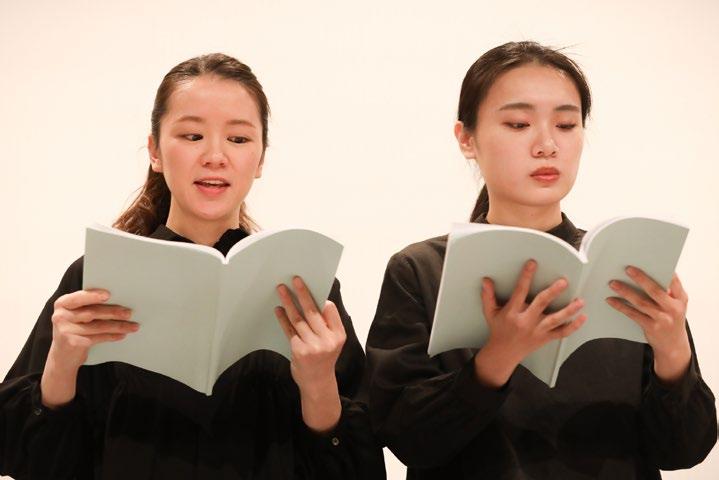
there had a strong impact. It was also the first play written by the Nigerian writer born in the UK.
Some people might not be familiar with Liberia. The media often covers the Middle East as a conflicted zone but African countries are seldom mentioned.
Liberia was founded in the nineteenth century by slaves who were freed and had returned from the US. The country name comes from the English word “liberty” referring to “freedom” that the former slaves had achieved themselves. However, the confrontation between the indigenous tribes and the American Liberians called “Americo-Liberians”, who are descendants of the freed slaves, created a complicated situation and in 1980, soldiers from local tribes launched a military coup. The civil war began when the American-Liberian Charles Taylor rose up against them and this is the backdrop of the play.
During the civil war that continued on and off for fourteen years since 1980, over 200,000 people were killed and a million people became evacuees and refugees. Moreover, 15,000 children fought with weapons as child soldiers and there were over 40,000 cases of sexual violence toward women.
The set for the reading only had chairs lined up in a row. The actors of Bungakuza wearing black clothes hummed as they
entered the stage and started talking. As they spoke each word with articulate diction and changed the tone of delivery, clear images were formed in our minds, taking the audience to wartime Liberia. The skills of the actors of Bungakuza, known as a theatre company placing importance on “text”, worked well for the reading.
The web of confrontation in Liberia’s civil war was very complex. During the time of the story, the Mano ethnic group, which the character Martha (played by Isoda Mie) belongs to, is cracked down by the National Patriotic Front of Liberia (NPFL) led by Charles Taylor, although they used to join forces. Martha soon has to go to ‘Sande Bush’ in order to go through a rite of passage into adulthood but she does not want to give up going to school despite the wish of her grandmother Mamie Esther (Yoshino Yoshiko).
The conversation between the grandmother and granddaughter is interrupted when their friend Amos (Kawabe Kunihiro) comes along and tells them that the rebels are coming. The situation women face during civil war is summarized in Amos’s words, “How many stories have we already heard
Yoshino Yoshiko
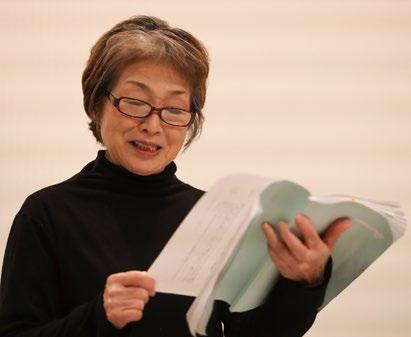
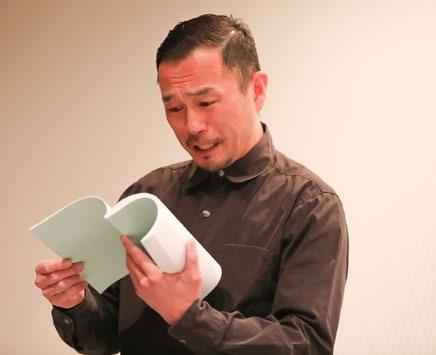
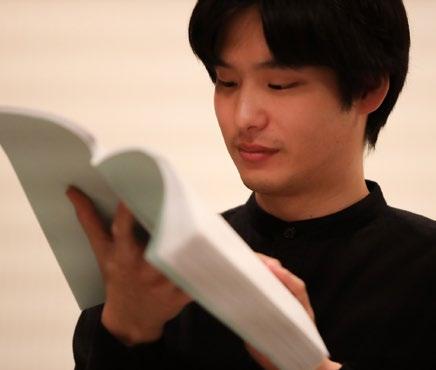
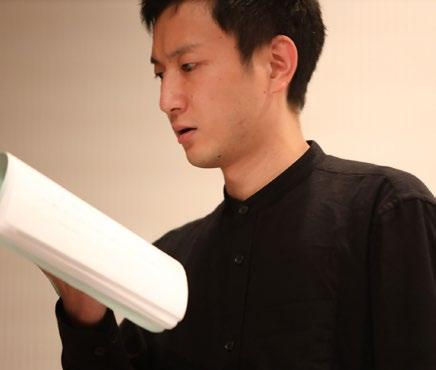
Kawabe Kunihiro
Kane Suzuki about the evil things the rebels, all sides, have been doing to our young daughters, eh?”
Martha dresses up as a boy to prevent being raped and heads toward Monrovia, the capital of Liberia, with her grandmother but when they reach the checkpoint, they are stopped by NPFL’s child soldiers named Killer (Kane Suzuki) and Double Trouble (Okuda Ippei) and are separated from each other. Ironically, Martha is mistaken for a boy and recruited as a child soldier. The wheel of fortune starts to spin and the story unfolds around Martha, now called “Jack”, surging with scenes full of tension.
The cruel and insane characters of Killer and Double Trouble, who could rape women or commit murder at any time, were depicted very vividly. They made us feel
uncomfortable not only because of their behaviour but because the translator Odashima chose words spoken by today’s young people, which made their dialogue sound very realistic. Suzuki and Okuda delivered the lines dynamically and made the characters even more powerful and real.
Martha has no idea what they would do to her when they find out that she is a girl. In order to survive, she has to behave like them. However, another girl named Finda (Nagatomi Chiaki) is brought along by force and ironically becomes yet another timebomb for Martha.
If it was just an accusation of “war crimes”, a docudrama would be all that was needed. But the author Atuona, in her wellcrafted debut work, questions violence and sexuality through the wavering identity of Martha, who disguises herself as a boy and is feeling as though she is walking across a minefield. The scene in which Killer prompted Martha to rape Finda is symbolic. Woman’s status is described in lurid detail from woman’s standpoint.
In another scene, the apparition of the grandmother Esther appears and criticizes Martha for turning into a child soldier. Martha’s pang of conscience and conflict are reflected in a skillful way, adding depth to the story. Isoda delicately expressed how Martha’s feelings had changed and made the audience feel empathy for her.
The play ends with a glimpse of hope. The story about civil war in a distant country resonated deeply inside the Japanese audience’s heart, perhaps because Martha symbolizes not only the people suffering from war but also the people who are oppressed by tyranny and discrimination. The boys, high on drugs given to them and filled with hatred toward the enemy instilled by the adults during military training, are also victims of the distorted world.
It also raises the question whether people can kill others in the name of war in order to protect themselves. Or whether we can maintain our humanity no matter what the situation may be. The play asks cutting and universal questions.
Before the reading started, Michael Jackson’s Liberian Girl (recorded in the album BAD) was played in the venue. The title of the play comes from this song and in the emotional love song, he sings, “You came and you changed my world”. The world does not change that easily. However, it will not change unless you really want to change it.
As a related project, a public talk was held before the reading performances of Liberian Girl. The title was “Contemporary Theatre in Israel—Looking at Motti Lerner’s The Murder of Isaac” and Professor Murai Hanayo of the Faculty of Arts and Letters at Kyoritsu Women’s University (specializing in Theories of Western Theatre and Israeli Theatre Studies) was invited to give a lecture.
Since the nation was founded in 1948, Israel has been in conflict with Palestine.
The Murder of Isaac (premiered in 1999 at the Municipal Theatre of Heilbronn, Germany) is a play about the assassination of then Israeli Prime Minister Yitzhak Rabin in November 1995 by a far-right Jewish fundamentalist. In 1993, peace negotiations between Palestine and Israel were under way following the historic Oslo Accords but the death of Rabin set back the peace efforts. The Murder of Isaac has a double structure of a play within a play. Inmates in a state-run PTSD rehab centre for the Israeli Defense Forces try to get to the bottom of Rabin’s assassination by putting on their own play.
Professor Murai explained about the origin and development of Israeli theatre culture in order to introduce the background of The Murder of Isaac. Theatre culture developed in Israel after the founding of the nation, getting through a series of wars, and it was also interesting to learn that theatre served as means to underpin the country’s existence. In addition, after the activities of Oded Kotler in the 1970s, public theatres have been seeking commercial success since the late 1980s. The professor also reported that plays dealing with Palestine had been excluded from the Acco (Acre) Theatre Festival in recent years, which is a worrying situation.
When President Trump relocated the US Embassy to Jerusalem,
he clearly showed that he was in favour of Israel, and since then, we have no clue as to whether Israel and Palestine will reach a peace agreement. To add to it, there is growing tension between the US and Iran since the beginning of 2020, and the situation in the Middle East remains unpredictable.
The Murder of Isaac deals with a sensitive issue that came as a big shock to the Israelis. Therefore, it has not been presented in Israel yet although it was performed in the US and Germany. The Murder of Isaac will be introduced to Japan at the ‘Theatre Born in Conflict Zones 12’ scheduled in December 2020 and the reading performances will surely become a rare and precious opportunity to present the play for a live audience. In theatre, contradictions and absurdities in the world that are not conveyed through news coverage can be brought to light through individuals. This kind of approach is only possible through theatre and it is something to look forward to.
Hamada, Motoko She joined The Mainichi Newspapers in 1989. After working in the Arts and Culture Department of Osaka Head Office, she moved to the Arts and Culture Department of Tokyo Head Office. She is in charge of contemporary theatre and entertainment. Besides writing dramatic reviews, she currently contributes articles for ‘Hibikore kangeki’ carried in the evening paper’s arts and culture corner and also web articles for ‘Butai juo tokidoki naname’. She studied at Rothberg International School at the Hebrew University of Jerusalem from 1995 to 1996.
(Translation: Sumida Michiyo)
Photographs taken by: Ishizawa Chieko (including the photograph on p185)
About the ‘Theatre Born in Conflict Zone’ series The centres of the International Theatre Institute (ITI) around the world have carried out projects called ‘Theatre Born in Conflict Zones’ as an attempt to build peace through theatre. The Japan Centre of ITI embarked on the ‘Theatre Born in Conflict Zones’ project in 2009 as part of the study and research for the publication of Theatre Yearbook. The series has continued for eleven years and twenty-six prominent plays not yet known in Japan have been introduced through translation, reading performances, lectures given by the authors, etc. The plays have been published from the third year of the series. If you wish to get hold of the booklet carrying the translation of Liberian Girl, please contact the Japan Centre of ITI.
‘Theatre Born in Conflict Zones 11’ <<Reading>> December 13-15, 2019 at Atelier West, Tokyo Metropolitan Theatre Title: Liberian Girl Written by Diana Nneka Atuona Translated by Odashima Soshi Directed by Inaba Kae (Bungakuza) Cast: Isoda Mie, Yoshino Yoshiko, Nagatomi Chiaki, Kane Suzuki, Okuda Ippei, Kawabe Kunihiro and Yokota Eiji (voice only) *All of them are members of Bungakuza.
Post-performance Talks Moderator: Seki Tomoko December 14: Inaba Kae, Odashima Soshi December 15: Inaba Kae, Odashima Soshi, Okano Hideyuki (specially appointed lecturer of the Faculty of Applied Sociology at Kindai University/ researcher in the fields of cultural anthropology, armed conflict and civil war)
Lecture December 12, 2019 in Room 1204 of the Main Building at the Ikebukuro Campus of Rikkyo University Theme: “Contemporary Theatre in Israel—Looking at Motti Lerner’s The Murder of Isaac” Lecturer: Professor Murai Hanayo of the Faculty of Arts and Letters at Kyoritsu Women’s University (Theories of Western Theatre and Israeli Theatre Studies Interviewer: Otani Kenjiro (stage director/ leader of ‘company ma’)
President Nagai Taeko
Vice-Presidents Abiko Tadashi Yoshiiwa Masaharu
Managing Director Sota Shuji
Directors
Auditors
Advisers Ataka Risako Ito Hiroshi Ozasa Yoshio Odagiri Yoko Kasuya Haruo Kida Yukinori Sakate Yoji Shindo Yoshikazu Nakayama Kaori Nomura Mansai Hayashi Hideki Bando Tamasaburo Hishinuma Yoshiaki Matsuda Kazuhiko Miwa Elica Wazaki Nobuya
Kishi Masato Kobayashi Hirofumi
Otani Nobuyoshi Kawamura Junko Sakomoto Jun-ichi Tanokura Minoru Nagae Iwao Nomura Man Hatano Yoshio Hori Takeo Matsuoka Isao
(As of March 27, 2020)
Companion Volume ‘Theatre Abroad 2020’ (Japanese)
These articles do not appear in ‘Theatre in Japan 2020’.
World Theatre Day Message by Shahid Nadeem
Theatre in Asia and Africa
China South Korea Laos
Iran South Africa Lebanon Israel
The Potential of Peking Opera---------------------------------------------------------------------------------------- Tamura Yoko
Interests in Debate and Process-Based Theatre---------------------------------------------------- Lee Seong-Kon
Dynamism Born from the Fusion of the Traditional and the Contemporary ------------------------------------------------------------------------------------------------------------------------------------------- Olé Khamchanla
The Iranian Theatre That Never Stops in Tehran----------------------------------------------- Naghmeh Samini
The Significance of Popular Theatre------------------------------------------------------------------------ Kusunose Keiko
Monodrama, or Theatre in a Time of Crisis----------------------------------------------------------------- Abido Bacha
At a Crossroads, Seventy Years on From Israel’s Founding---------------------------------- Murai Hanayo
Theatre in the Americas and Oceania
USA Brazil New Zealand
An Overview of the State of the Performing Arts in New York and America---- Shioya Yoko
Brazilian Theatre and the Impact of the New Government’s Policies----- Maria Fernanda Bomero
At the Intersection of Culture: Performing Arts by Maori, Pacific Islander Migrants, and Asian Migrants ------------------------------------------------------------------------------------------------------------------------ Kosugi Sei
Theatre in Europe
UK Ireland Germany / Austria / Switzerland France Greece Macedonia Russia
The Principles and Reality of the European Family--------------------------------------- Motohashi Tetsuya
Portrayals of Women and Multidisciplinary Adaptations------------------------------- Sakauchi Futoshi
Opposition to and Acceptance of Multiculturalism, a Continuing Conflict ----------------------------------------------------------------------------------------------------------------------------------------------- Hagiwara Ken
A Lingering Disquiet: The Trigger for the Future?---------------------------------------------------- Fujii Shintaro
Classical Theatre Ten Years on from the Financial Crisis----------------------------------- Yamagata Harue
I Am Not Wild Flesh, Theatre Is No Twig in the Wind------------------------- Ivanka Apostolova Baskar
Year of Theatre 2019: The Enduring Power of Theatre--------------------------------------Shinozaki Naoya
Developments in Japan and Overseas
Round-Table Discussion: Performing Arts Across Borders —Looking Back on International Exchange during the Thirty Years of the Heisei Era ———————————————— Sato Maimi, Miyagi Satoshi and Nakamura Akane (Moderator: Date Natsume)




